Abstract
The effect of gastric fundectomy with hypergastrinaemia on the pancreas in rats was studied for 14 months. Rats with hypercholecystokininaemia that had had a pancreaticobiliary diversion (PBD) operation and sham operated rats served as controls. Fundectomised rats showed a significant increase in pancreatic weight and total DNA and protein content compared with sham operated rats. DNA flow cytometry showed a significantly higher ratio of tetraploid to diploid nuclei in pancreatic tissue after fundectomy than after sham operation. Mean values of all these variables were significantly lower after fundectomy than after PBD. Acidophilic atypical acinar cell foci of the pancreas were diagnosed in both fundectomised and PBD operated rats, but not in sham operated controls. The volume density and 3H-thymidine labelling index of the acidophilic atypical acinar cell foci were significantly lower after fundectomy than after PBD. Changes consistent with pancreatic adenoma were diagnosed in the PBD group only. In conclusion, fundectomy lasting about half of the life span in rats causes pancreatic hyperplasia and hypertrophy, as well as development of acidophilic atypical acinar cell foci. Although hypergastrinaemia is a prominent feature, it may not be the only factor responsible for this pancreaticotrophical effect of fundectomy.
Full text
PDF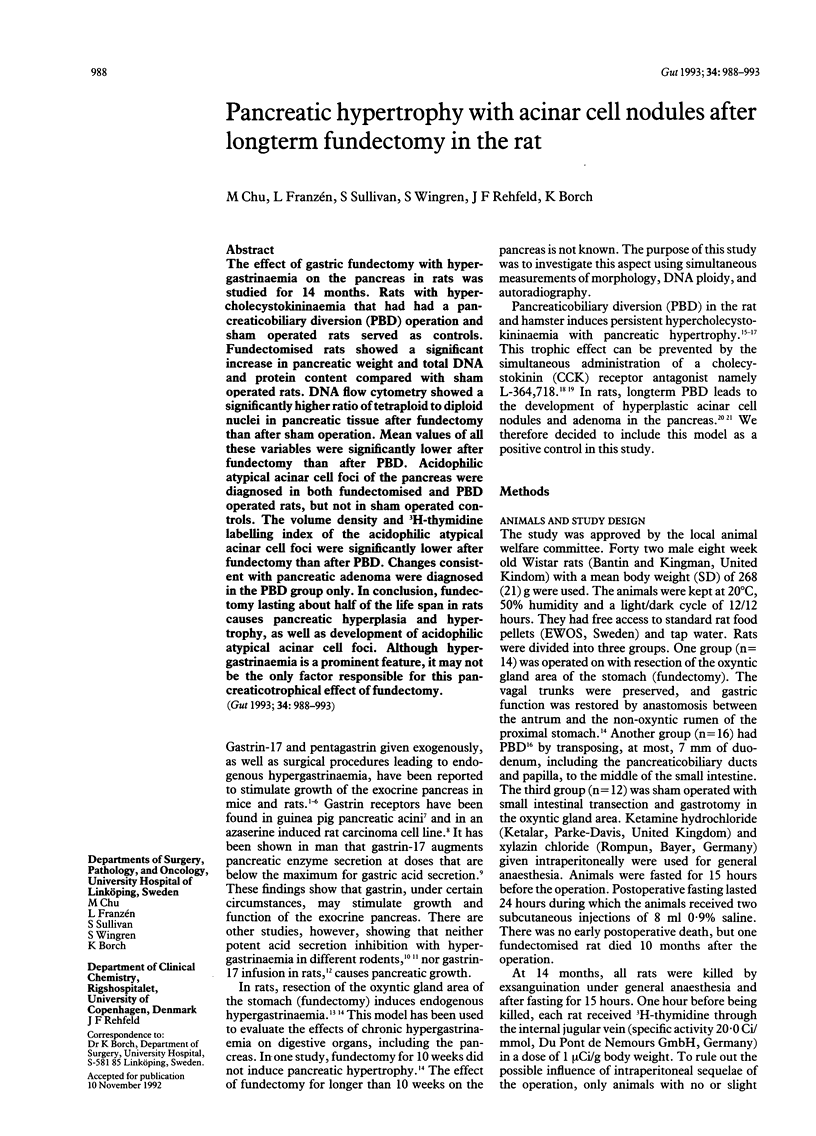
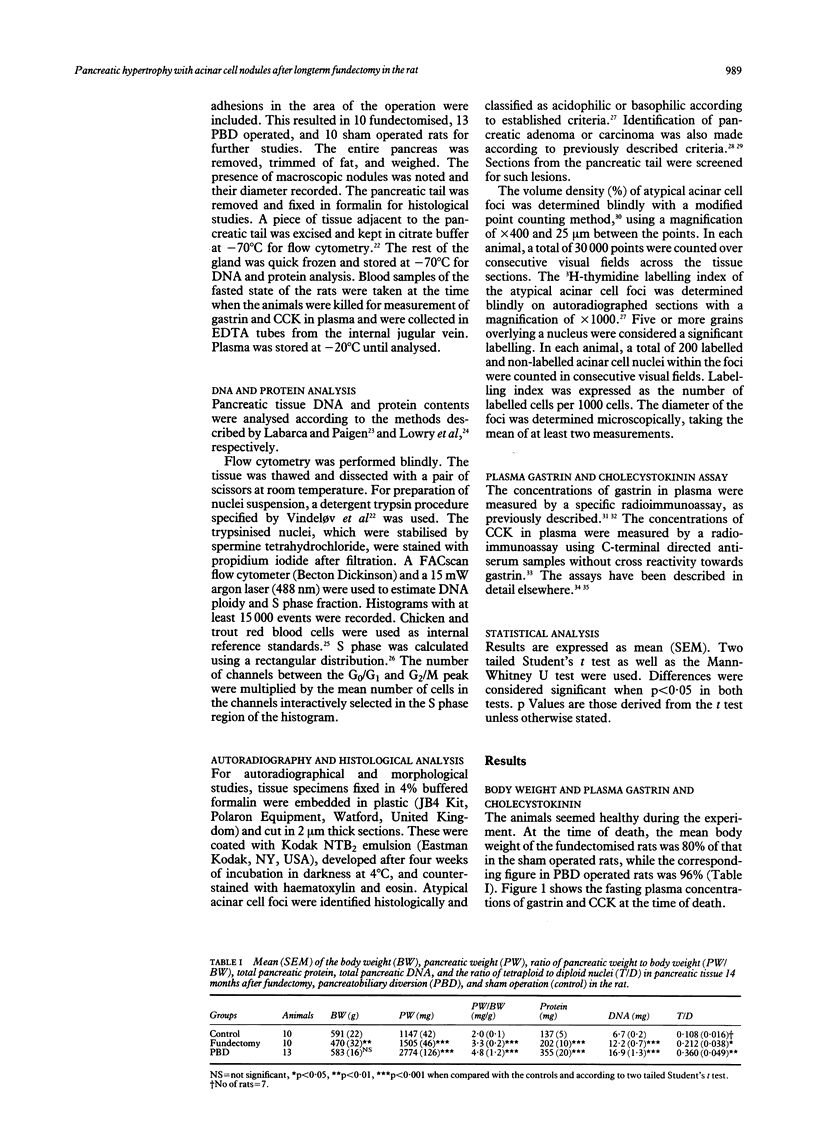
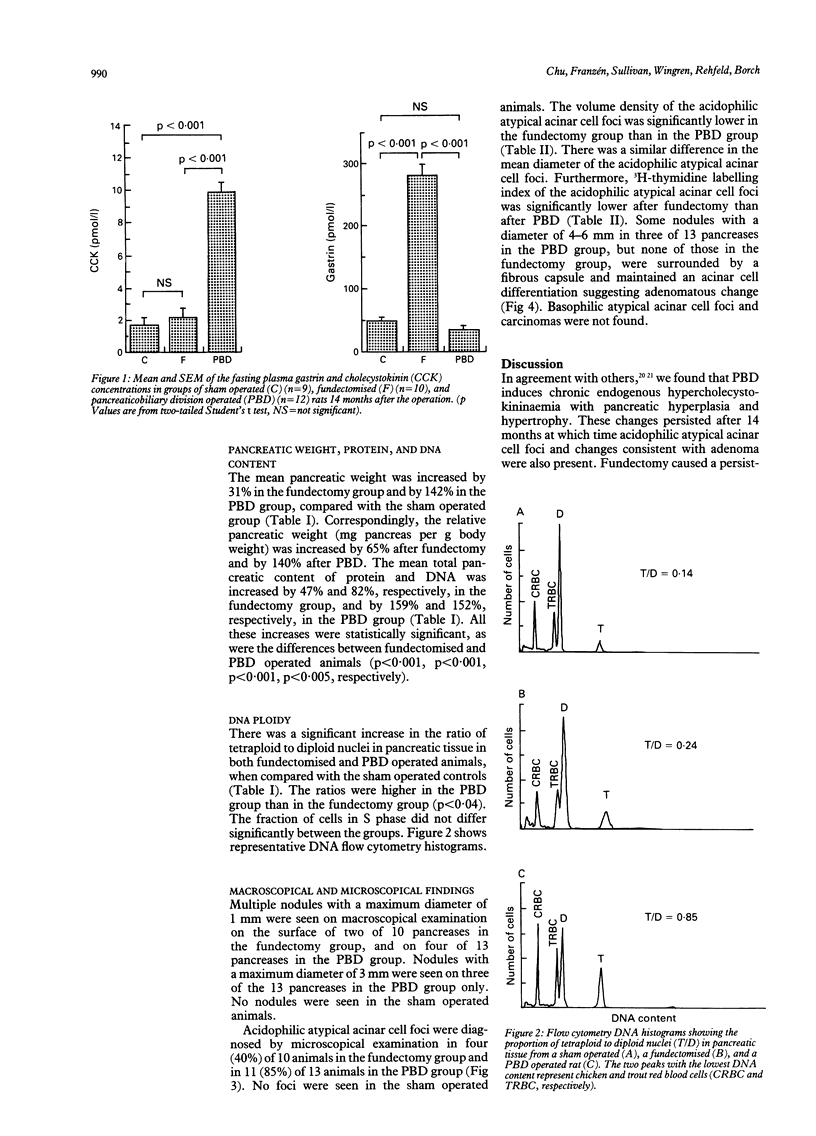
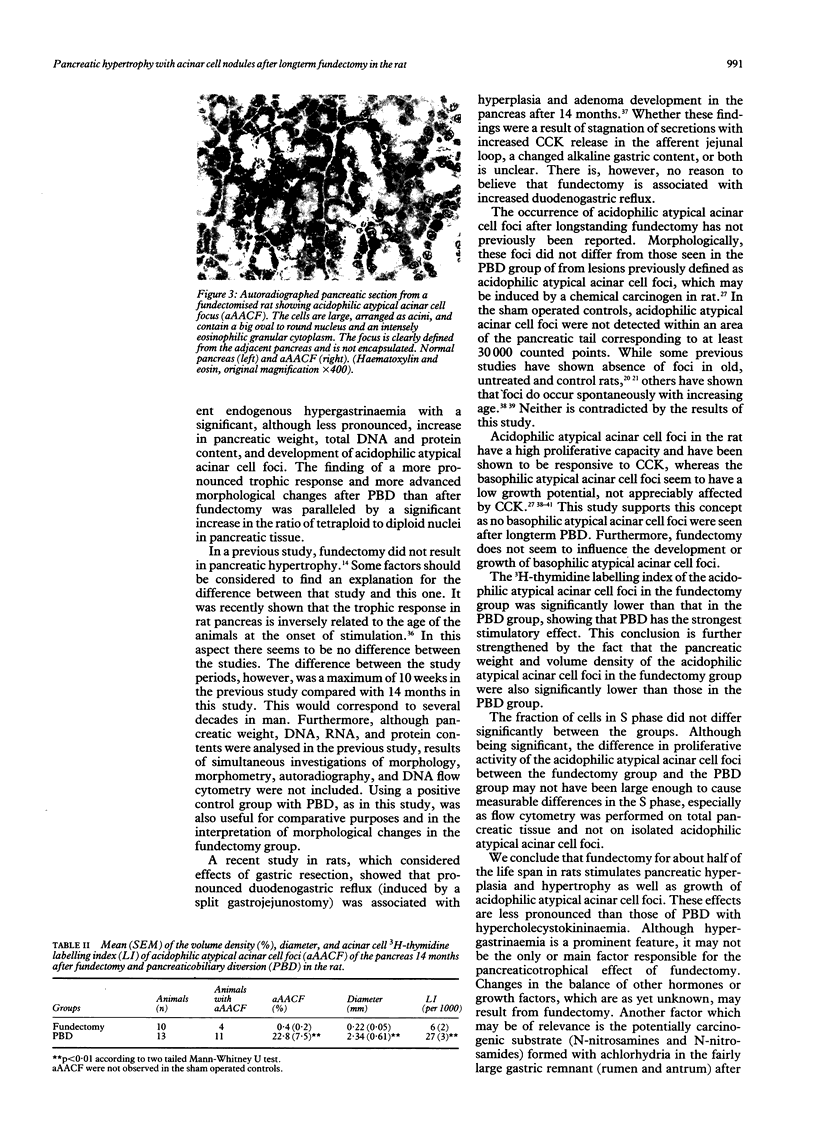
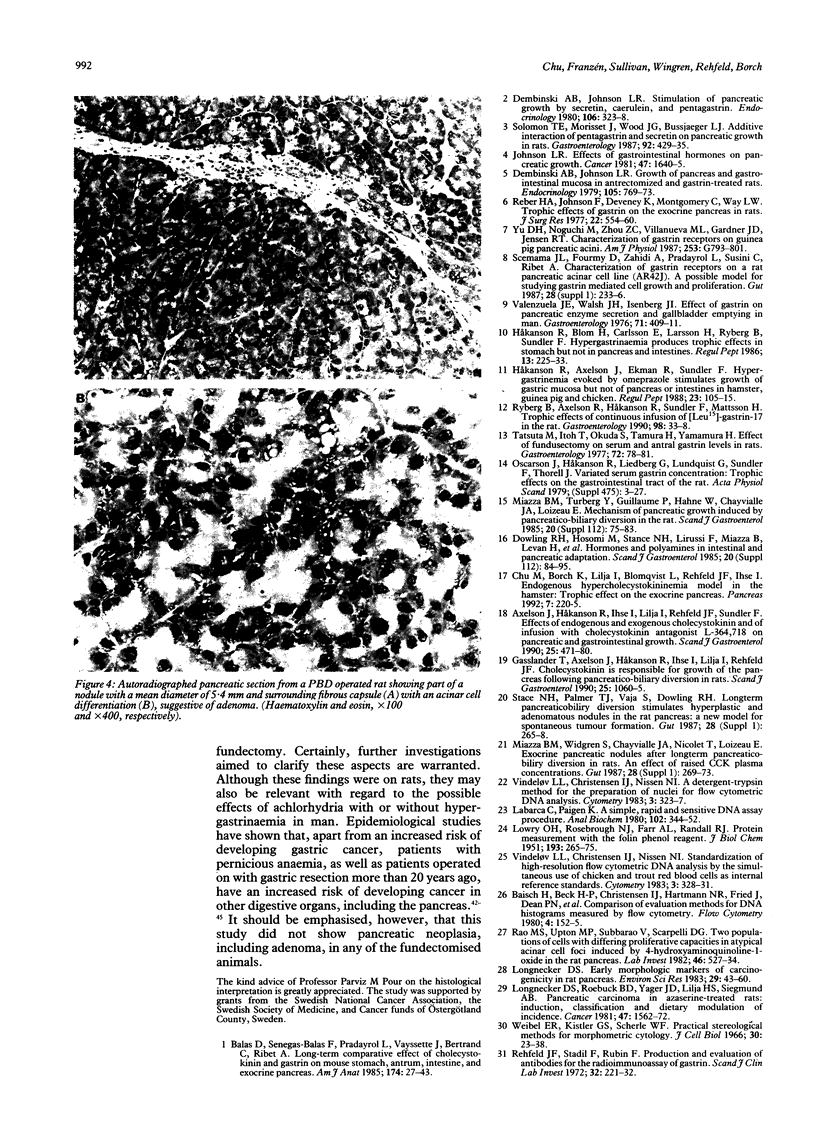
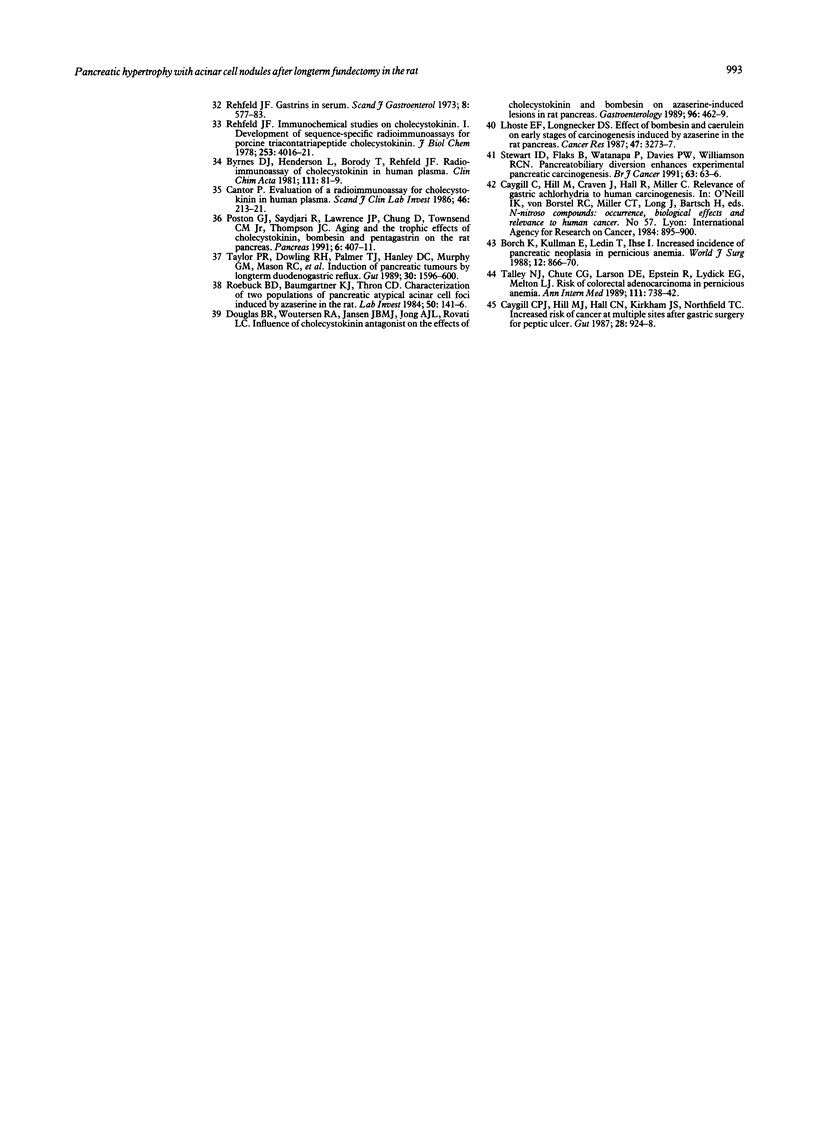
Images in this article
Selected References
These references are in PubMed. This may not be the complete list of references from this article.
- Axelson J., Håkanson R., Ihse I., Lilja I., Rehfeld J. F., Sundler F. Effects of endogenous and exogenous cholecystokinin and of infusion with the cholecystokinin antagonist L-364,718 on pancreatic and gastrointestinal growth. Scand J Gastroenterol. 1990 May;25(5):471–480. doi: 10.3109/00365529009095518. [DOI] [PubMed] [Google Scholar]
- Balas D., Senegas-Balas F., Pradayrol L., Vayssette J., Bertrand C., Ribet A. Long-term comparative effect of cholecystokinin and gastrin on mouse stomach, antrum, intestine, and exocrine pancreas. Am J Anat. 1985 Sep;174(1):27–43. doi: 10.1002/aja.1001740104. [DOI] [PubMed] [Google Scholar]
- Borch K., Kullman E., Hallhagen S., Ledin T., Ihse I. Increased incidence of pancreatic neoplasia in pernicious anemia. World J Surg. 1988 Dec;12(6):866–870. doi: 10.1007/BF01655502. [DOI] [PubMed] [Google Scholar]
- Byrnes D. J., Henderson L., Borody T., Rehfeld J. F. Radioimmunoassay of cholecystokinin in human plasma. Clin Chim Acta. 1981 Mar 19;111(1):81–89. doi: 10.1016/0009-8981(81)90424-1. [DOI] [PubMed] [Google Scholar]
- Cantor P. Evaluation of a radioimmunoassay for cholecystokinin in human plasma. Scand J Clin Lab Invest. 1986 May;46(3):213–221. doi: 10.3109/00365518609083662. [DOI] [PubMed] [Google Scholar]
- Caygill C. P., Hill M. J., Hall C. N., Kirkham J. S., Northfield T. C. Increased risk of cancer at multiple sites after gastric surgery for peptic ulcer. Gut. 1987 Aug;28(8):924–928. doi: 10.1136/gut.28.8.924. [DOI] [PMC free article] [PubMed] [Google Scholar]
- Chu M., Borch K., Lilja I., Blomqvist L., Rehfeld J. F., Ihse I. Endogenous hypercholecystokininemia model in the hamster: trophic effect on the exocrine pancreas. Pancreas. 1992;7(2):220–225. doi: 10.1097/00006676-199203000-00014. [DOI] [PubMed] [Google Scholar]
- Dembinski A. B., Johnson L. R. Growth of pancreas and gastrointestinal mucosa in antrectomized and gastrin-treated rats. Endocrinology. 1979 Sep;105(3):769–773. doi: 10.1210/endo-105-3-769. [DOI] [PubMed] [Google Scholar]
- Dembinski A. B., Johnson L. R. Stimulation of pancreatic growth by secretin, caerulein, and pentagastrin. Endocrinology. 1980 Jan;106(1):323–328. doi: 10.1210/endo-106-1-323. [DOI] [PubMed] [Google Scholar]
- Douglas B. R., Woutersen R. A., Jansen J. B., de Jong A. J., Rovati L. C., Lamers C. B. Influence of cholecystokinin antagonist on the effects of cholecystokinin and bombesin on azaserine-induced lesions in rat pancreas. Gastroenterology. 1989 Feb;96(2 Pt 1):462–469. doi: 10.1016/0016-5085(89)91572-2. [DOI] [PubMed] [Google Scholar]
- Dowling R. H., Hosomi M., Stace N. H., Lirussi F., Miazza B., Levan H., Murphy G. M. Hormones and polyamines in intestinal and pancreatic adaptation. Scand J Gastroenterol Suppl. 1985;112:84–95. doi: 10.3109/00365528509092217. [DOI] [PubMed] [Google Scholar]
- Gasslander T., Axelson J., Håkanson R., Ihse I., Lilja I., Rehfeld J. F. Cholecystokinin is responsible for growth of the pancreas after pancreaticobiliary diversion in rats. Scand J Gastroenterol. 1990 Oct;25(10):1060–1065. doi: 10.3109/00365529008997635. [DOI] [PubMed] [Google Scholar]
- Håkanson R., Axelson J., Ekman R., Sundler F. Hypergastrinaemia evoked by omeprazole stimulates growth of gastric mucosa but not of pancreas or intestines in hamster, guinea pig and chicken. Regul Pept. 1988 Oct;23(1):105–115. doi: 10.1016/0167-0115(88)90426-0. [DOI] [PubMed] [Google Scholar]
- Håkanson R., Blom H., Carlsson E., Larsson H., Ryberg B., Sundler F. Hypergastrinaemia produces trophic effects in stomach but not in pancreas and intestines. Regul Pept. 1986 Feb;13(3-4):225–233. doi: 10.1016/0167-0115(86)90041-8. [DOI] [PubMed] [Google Scholar]
- Johnson L. R. Effects of gastrointestinal hormones on pancreatic growth. Cancer. 1981 Mar 15;47(6 Suppl):1640–1645. doi: 10.1002/1097-0142(19810315)47:6+<1640::aid-cncr2820471430>3.0.co;2-s. [DOI] [PubMed] [Google Scholar]
- LOWRY O. H., ROSEBROUGH N. J., FARR A. L., RANDALL R. J. Protein measurement with the Folin phenol reagent. J Biol Chem. 1951 Nov;193(1):265–275. [PubMed] [Google Scholar]
- Labarca C., Paigen K. A simple, rapid, and sensitive DNA assay procedure. Anal Biochem. 1980 Mar 1;102(2):344–352. doi: 10.1016/0003-2697(80)90165-7. [DOI] [PubMed] [Google Scholar]
- Lhoste E. F., Longnecker D. S. Effect of bombesin and caerulein on early stages of carcinogenesis induced by azaserine in the rat pancreas. Cancer Res. 1987 Jun 15;47(12):3273–3277. [PubMed] [Google Scholar]
- Longnecker D. S., Roebuck B. D., Yager J. D., Jr, Lilja H. S., Siegmund B. Pancreatic carcinoma in azaserine-treated rats: induction, classification and dietary modulation of incidence. Cancer. 1981 Mar 15;47(6 Suppl):1562–1572. doi: 10.1002/1097-0142(19810315)47:6+<1562::aid-cncr2820471419>3.0.co;2-z. [DOI] [PubMed] [Google Scholar]
- Miazza B. M., Turberg Y., Guillaume P., Hahne W., Chayvialle J. A., Loizeau E. Mechanism of pancreatic growth induced by pancreatico-biliary diversion in the rat. Inhibition by proglumide, benzotript, and ranitidine. Scand J Gastroenterol Suppl. 1985;112:75–83. doi: 10.3109/00365528509092216. [DOI] [PubMed] [Google Scholar]
- Miazza B. M., Widgren S., Chayvialle J. A., Nicolet T., Loizeau E. Exocrine pancreatic nodules after longterm pancreaticobiliary diversion in rats. An effect of raised CCK plasma concentrations. Gut. 1987;28 (Suppl):269–273. doi: 10.1136/gut.28.suppl.269. [DOI] [PMC free article] [PubMed] [Google Scholar]
- Poston G. J., Saydjari R., Lawrence J. P., Chung D., Townsend C. M., Jr, Thompson J. C. Aging and the trophic effects of cholecystokinin, bombesin and pentagastrin on the rat pancreas. Pancreas. 1991 Jul;6(4):407–411. doi: 10.1097/00006676-199107000-00006. [DOI] [PubMed] [Google Scholar]
- Rao M. S., Upton M. P., Subbarao V., Scarpelli D. G. Two populations of cells with differing proliferative capacities in atypical acinar cell foci induced by 4-hydroxyaminoquinoline-1-oxide in the rat pancreas. Lab Invest. 1982 May;46(5):527–534. [PubMed] [Google Scholar]
- Reber H. A., Johnson F., Deveney K., Montgomery C., Way L. W. Trophic effects of gastrin on the exocrine pancreas in rats. J Surg Res. 1977 May;22(5):554–560. doi: 10.1016/0022-4804(77)90040-3. [DOI] [PubMed] [Google Scholar]
- Rehfeld J. F. Gastrins in serum. A review of gastrin radioimmunoanalysis and the discovery of gastrin heterogeneity in serum. Scand J Gastroenterol. 1973;8(7):577–583. [PubMed] [Google Scholar]
- Rehfeld J. F. Immunochemical studies on cholecystokinin. I. Development of sequence-specific radioimmunoassays for porcine triacontatriapeptide cholecystokinin. J Biol Chem. 1978 Jun 10;253(11):4016–4021. [PubMed] [Google Scholar]
- Roebuck B. D., Baumgartner K. J., Thron C. D. Characterization of two populations of pancreatic atypical acinar cell foci induced by azaserine in the rat. Lab Invest. 1984 Feb;50(2):141–146. [PubMed] [Google Scholar]
- Ryberg B., Axelson J., Håkanson R., Sundler F., Mattsson H. Trophic effects of continuous infusion of [Leu15]-gastrin-17 in the rat. Gastroenterology. 1990 Jan;98(1):33–38. doi: 10.1016/0016-5085(90)91287-g. [DOI] [PubMed] [Google Scholar]
- Scemama J. L., Fourmy D., Zahidi A., Pradayrol L., Susini C., Ribet A. Characterisation of gastrin receptors on a rat pancreatic acinar cell line (AR42J). A possible model for studying gastrin mediated cell growth and proliferation. Gut. 1987;28 (Suppl):233–236. doi: 10.1136/gut.28.suppl.233. [DOI] [PMC free article] [PubMed] [Google Scholar]
- Solomon T. E., Morisset J., Wood J. G., Bussjaeger L. J. Additive interaction of pentagastrin and secretin on pancreatic growth in rats. Gastroenterology. 1987 Feb;92(2):429–435. doi: 10.1016/0016-5085(87)90138-7. [DOI] [PubMed] [Google Scholar]
- Stace N. H., Palmer T. J., Vaja S., Dowling R. H. Longterm pancreaticobiliary diversion stimulates hyperplastic and adenomatous nodules in the rat pancreas: a new model for spontaneous tumour formation. Gut. 1987;28 (Suppl):265–268. doi: 10.1136/gut.28.suppl.265. [DOI] [PMC free article] [PubMed] [Google Scholar]
- Stewart I. D., Flaks B., Watanapa P., Davies P. W., Williamson R. C. Pancreatobiliary diversion enhances experimental pancreatic carcinogenesis. Br J Cancer. 1991 Jan;63(1):63–66. doi: 10.1038/bjc.1991.13. [DOI] [PMC free article] [PubMed] [Google Scholar]
- Talley N. J., Chute C. G., Larson D. E., Epstein R., Lydick E. G., Melton L. J., 3rd Risk for colorectal adenocarcinoma in pernicious anemia. A population-based cohort study. Ann Intern Med. 1989 Nov 1;111(9):738–742. doi: 10.7326/0003-4819-111-9-738. [DOI] [PubMed] [Google Scholar]
- Tatsuta M., Itoh T., Okuda S., Tamura H., Yamamura H. Effect of fundusectomy on serum and antral gastrin levels in rats. Gastroenterology. 1977 Jan;72(1):78–81. [PubMed] [Google Scholar]
- Taylor P. R., Dowling R. H., Palmer T. J., Hanley D. C., Murphy G. M., Mason R. C., McColl I. Induction of pancreatic tumours by longterm duodenogastric reflux. Gut. 1989 Nov;30(11):1596–1600. doi: 10.1136/gut.30.11.1596. [DOI] [PMC free article] [PubMed] [Google Scholar]
- Valenzuela J. E., Walsh J. H., Isenberg J. I. Effect of gastrin on pancreatic enzyme secretion and gallbladder emptying in man. Gastroenterology. 1976 Sep;71(3):409–411. [PubMed] [Google Scholar]
- Vindeløv L. L., Christensen I. J., Nissen N. I. A detergent-trypsin method for the preparation of nuclei for flow cytometric DNA analysis. Cytometry. 1983 Mar;3(5):323–327. doi: 10.1002/cyto.990030503. [DOI] [PubMed] [Google Scholar]
- Vindeløv L. L., Christensen I. J., Nissen N. I. Standardization of high-resolution flow cytometric DNA analysis by the simultaneous use of chicken and trout red blood cells as internal reference standards. Cytometry. 1983 Mar;3(5):328–331. doi: 10.1002/cyto.990030504. [DOI] [PubMed] [Google Scholar]
- Weibel E. R., Kistler G. S., Scherle W. F. Practical stereological methods for morphometric cytology. J Cell Biol. 1966 Jul;30(1):23–38. doi: 10.1083/jcb.30.1.23. [DOI] [PMC free article] [PubMed] [Google Scholar]
- Yu D. H., Noguchi M., Zhou Z. C., Villanueva M. L., Gardner J. D., Jensen R. T. Characterization of gastrin receptors on guinea pig pancreatic acini. Am J Physiol. 1987 Dec;253(6 Pt 1):G793–G801. doi: 10.1152/ajpgi.1987.253.6.G793. [DOI] [PubMed] [Google Scholar]




